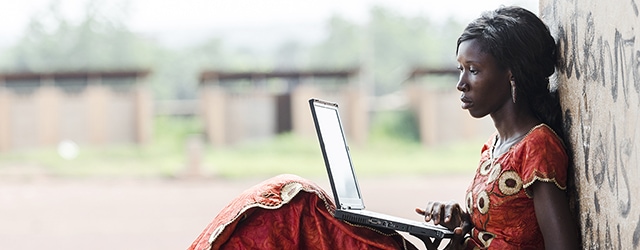By drone or by cable, Google, Facebook and other tech giants are vying to unlock Africa’s trove of potential subscribers who still lack internet access.

In July, Loon, Google’s sister company, launched 35 giant internet balloons in the sky over Kenya. Equipped with 4G long-term evolution broadband devices, each Loon balloon delivers mobile internet for everything from email to web browsing to or voice calls within a radius of 50,000 square kilometers on the ground.
“Kenya is the first country … to have base stations high up in the sky,” Information Minister Joe Mucheru told the press. “Now, we will be able to cover the whole country in a very short span of time.” In front of the cameras, he video-called President Uhuru Kenyatta using the new connection.
Some 4 billion people—slightly more than half the world’s population—do not have access to the internet; many of them live in Africa. Sub-Saharan Africa’s internet penetration is only 39% compared to 59% globally. The continent is now a connectivity battleground as Google, Facebook and other big techs compete over infrastructure projects that aim to connect Africa and usher in hundreds of millions of new users.
Loon’s rollout in Kenya is its biggest challenge yet and a pivotal bid for market validation. The bet is that in remote areas, balloons will prove cheaper than building towers or pulling fiber cables.
Loon’s Kenya venture is a partnership with Telkom Kenya, the country’s third largest telco. Telecom providers in other countries are closely watching how it plays out and getting ready to sign similar deals.
They may have some catching up to do. Late last year, Loon signed a second deal with Vodacom, Africa’s second largest telco, to roll out its product in Mozambique, where only 20% of the 31 million inhabitants currently have internet access. The balloons will provide connectivity to Cabo Delgado and Niassa, two remote provinces that telcos have difficulty reaching through traditional means.
Minding The Competition
In the scramble to connect Africa the real battle is taking place under water. Undersea cables currently support more than 99% of global internet traffic. Two tech giants, along with other players, are competing to lay hundreds of thousands of miles of fiber-optic cable on the ocean floor.
Most broadband submarine cables arrive to Africa’s west coast; a few, such as SEACOM, take another route from Europe to Africa’s east coast through the Mediterranean Sea and the Suez Canal, but the east coast remains largely underserved. To answer the challenge, Facebook is leading 2Africa (formerly Simba), an international partnership that announced plans this year to roll out a cable from Europe to the Arabian Peninsula, circling Africa, plugging in 16 countries along the way.
The cost of the project is undisclosed, but reports place it just under $1 billion. Investors reportedly include China Mobile Intenational, South Africa’s MTN GlobalConnect, France’s Orange, Saudi Telecom, Telecom Egypt and the UK’s Vodafone.
The partners claim the new cable will provide more capacity than all existing sources. Upon completion in 2024, they say, it will more than double the continent’s internet capacity. Not to be beaten to the punch, Google announced it will build its own private cable connecting Portugal to South Africa, with the first landing, in Nigeria, expected in 2021.
Whether by drone or cable, all of these big investors are counting on unlocking an enormous new consumer market. “We classify 330 million Africans as in the consumer class, meaning they have the asset profile, demographics and income to suggest they’re ready and able to consume goods,” says Dustin Homer director of solutions at Fraym, a digital start-up specializing in data collection in Africa.
The continent’s biggest markets, such as Egypt, Morocco, Algeria, South Africa and Nigeria, are already far along with regard to connectivity. But sub-Saharan Africa offers two sleeping giants: Ethiopia, with 110 million people, and the Democratic Republic of Congo (DRC). “Ethiopia has huge untapped opportunity and is starting to open up possibilities for telecom investment,” says Homer. “The DRC, despite many challenges, has a huge emerging segment of the population that is ready and able to consume more. Bold investors should take a close look at DRC.”
Other countries such as Burundi, Chad, Eritrea, Madagascar, South Sudan and Western Sahara, which currently have less than 10% internet penetration, also offer vast opportunities.
If successful, the new technologies currently being tested in Africa could be replicated in other parts of the world, notably in South America and Asia, where remote areas are still home to pools of potential new internet users.



